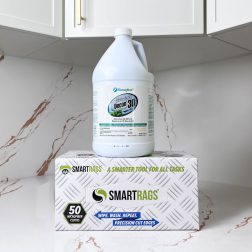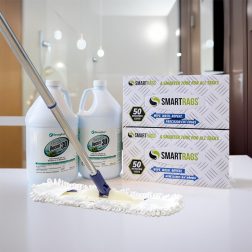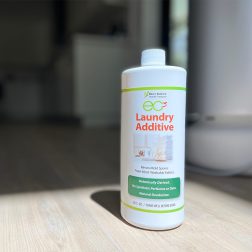No products in the cart.
For most of us, cleaning isn’t at the top of the activities we genuinely enjoy. More often than not, this task gets pushed off, and our attention is focused on the hustle and bustle of daily life instead. And out-of-sight or difficult-to-clean areas of the home? Forget about it! Unfortunately for all anti-cleaning fanatics, this process, particularly spring cleaning, is a vital piece of the puzzle in home health.
Why Spring Cleaning Is Important
During this flowery month, an abundance of allergens floating around outdoors enters a home and settles in the dust. We’re looking at you, pollen… Then, these particles circulate throughout the indoor space, lowering indoor air quality and entering our bodies through inhalation.
It also rains more frequently in places around the world. That results in an abundance of mold in the air, which will then migrate into our homes. Like other particles, such as pollen, these particles will settle in our dust and begin circulating and building up throughout the indoor space.
Another factor to consider is that there’s very little airflow transfer between indoor and outdoor environments, thanks to modern building practices that promote net-zero energy efficiency. This means that most microscopic particles, like allergens, mold spores, and mycotoxins, that make their way inside our homes will remain there until they’re actively removed.
Cleaning is key during this time of year to eliminate those particles, improve our air quality, and help prevent mold! So, schedule a day to throw on your favorite cleaning outfit, blast that music playlist, and jump into giving your home a sparkly, fresh feel.
The Spring Cleaning Process

Don’t just dive into spring cleaning willy-nilly! If you’re spending time and effort cleaning your home and improving indoor air quality, ensure you’re doing it right and removing as many contaminants as possible.
Here’s your guide to success:
- Go room by room. It’s a time-consuming process, but it will ensure that your entire space is clean, not just commonly frequented areas like the kitchen and bathroom.
- Throw all machine-washable items in the laundry.
- Turn on the air purifier. This machine will help eliminate microscopic particles that get kicked up during cleaning.
- Begin deep cleaning items that need to be soaked, like the showerhead, sink faucets, toothbrushes, parts of appliances, etc.
- Work top to bottom. As you go, don’t forget to remove items from shelves and shift larger pieces of furniture from their original spots.
- Dust all surfaces with a slightly damp microfiber cloth or HEPA vacuum cleaner, depending on the surface type.
- Clean every available surface (including nooks and crannies!) using the correct products for the job. Check the dwell time for each product and then wipe with a microfiber towel.
- Use a HEPA vacuum cleaner for the floors, followed by a botanical cleanser. Mist the floor so particles don’t aerosolize further while you mop the floor. Use a microfiber mop to wipe the product away.
- Allow everything to dry completely so that moisture doesn’t remain in the space because this can allow for microbial growth. Some species of mold can grow in as little as 24-48 hours, given a wet surface.
- Move on to any outside tasks or address structural issues you’ve found.
By the end of this process, your house will be sparkling clean and supporting your wellness.
Check out our cleaning kit for all of the products we use during spring cleaning.
-

Mold & Bacteria Contents Cleaning
Remove harmful pollutants that accumulate in the dust of your home. (Options available for renters...
-
$99.00 – $349.00 SHOP NOW -

HomeCleanse Cleaning
Take your cleaning to the next level buying all the tools we use to keep...
-
$299.00 – $549.00 SHOP NOW -

EC3 Laundry Additive
Add EC3 to every rinse cycle to rinse away mold, bacteria and musty odors from...
-
$23.00 SHOP NOW
Tips For Success
The cleaner your home is, the fewer particles will be hanging around and potentially causing issues—so be thorough! Check off the steps below to ensure you get the most out of your cleaning extravaganza.
1. Use These Right Tools
You want cleaning tools that will actually remove contaminants from your environment so that they don't continue to build up. Make sure your cleaning arsenal has these products.
a) Microfiber cloths
These are invaluable cleaning tools because they are 100 times more effective at removing particles than cotton towels.
b) Botanical laundry additive
This product helps rinse away bacteria and mold spores that get trapped in the fibers of the item. As a bonus, it also helps remove particles from the washing machine itself.
c) Botanical cleaners with surfactants
Instead of harsh chemicals like bleach, which can lower indoor air quality, trigger health reactions in sensitive individuals, and harm the environment, botanical products utilize natural ingredients to deal with contaminants. Surfactants in the products then help remove particles from the surface so they don’t get left behind and continue to build up.
d) HEPA vacuum cleaner
The filtration portion of the machine is what sets HEPA vacuums apart. While other machines will filter out the majority of smaller particles, they can’t stop some ultra-fine and microscopic particles like mold spores. The technology behind HEPA filters allows them to filter out and remove smaller particles instead of just blowing them back into the surrounding environment. To reach the EPA standard and be qualified as a HEPA filter, they must filter out 99.7% of particles that pass through that are 0.3 microns in size.
2. Prioritize Out-of-Sight Areas
Ultimately, this process aims to clean as deeply and thoroughly as possible, tackling all spaces that don’t get a ton of attention throughout the year. Also, when cleaning certain areas, move all furniture, belongings, appliances, etc., and clean behind them. These spaces can develop a built-up layer of microscopic particles that must be removed to promote a healthier home.
A few examples are:
- Sink faucets
- Showerhead
- Shower rods and hooks
- Inside cabinets
- Trash can
- Dishwasher filter
- Bathtub jets

3. Target Appliances
Appliances are some of the top places for microbial growth in a home because they use liquid. Cleaning them helps remove contaminants like mold spores, bacteria, and mycotoxins and prevent microbial growth in the machines. Check the manufacturer’s instructions for cleaning methods, products, and frequency suggestions.
A few top appliances to focus on while spring cleaning include:
- Dishwasher
- Laundry machine
- Coffee maker
- Refrigerator (including the water spout and water line)
- Blender
- Juicer
- Microwave
- Air fryer
4. Dust Everything
Microscopic particles settle where dust settles. That layer of visible grime contains indoor contaminants like mold spores, mycotoxins, and bacteria that will become airborne when the dust is disturbed.
Dusting helps reduce the number of microscopic particles in the indoor environment so they don’t continue to build up. HEPA vacuum cleaners and damp microfiber towels are the best tools for eliminating these particles from your home. The fewer particles on the home's surfaces, the cleaner the air and indoor space will be.
Don’t forget these surfaces while dusting:
- Lights
- Ceiling fan blades
- AC vents
- Doorframes
- Windowsills
- Shelves
- Wall decor
- TVs
5. Change Air Filters
Spring cleaning is a great time to change these filters. This will ensure the filter is prepped and ready to eliminate as many contaminants as possible that enter the home from the particle-filled outdoor air.
Air filters are the first line of defense both for the HVAC system and your indoor air. These barriers help eliminate contaminants so that they don’t continue to circulate throughout the indoor space. It also helps remove them before they reach the HVAC, which can help avoid microbial growth in the unit itself.
That said, if they’re past their time to be replaced, they’re likely packed full of particles. This will affect their ability to filter, leading to lower indoor air quality. It can also strain the HVAC system as it works overtime to pull air through the clogged filters.
Switching to the highest-rated MERV filters for the specific HVAC system is also good. The key thing to keep in mind is that the smaller the particles these filters can eliminate, the better. When dealing with microscopic particles like mold spores and mycotoxins, you want filters that can eliminate them from the air. Otherwise, they’ll just circulate straight back into the home.
6. Wash Porous Items With a Botanical Laundry Additive
Porous items are particularly difficult to clean because microscopic particles like pollen and mold spores can settle within the fibers of the surface. A botanical laundry additive can help remove microscopic particles from the surface so they don’t continue to build up and become airborne when the surface is disturbed. As a bonus, it also helps keep the washing machine clean and healthy.
Some things to target include:
- Bathmat
- Shower curtain and liner
- Blankets
- Mattress and pillow protectors
- Towels
- Bedding
- Clothing
- Dog beds
- Pillowcases
We recommend EC3 Laundry Additive.
7. Reduce Clutter
While cleaning, work to minimize the number of belongings in the home. The more personal items we have, the more surfaces dust and microscopic particles like pollen can collect on, and the harder it is to clean a home properly. Every year, evaluate your belongings and ask yourself if you truly use each item before deciding whether to keep it or move on from it. Doing so will make future cleaning easier and more thorough, ultimately translating to cleaner indoor air quality and improved wellness.
8. Schedule an HVAC Service Appointment
The HVAC is essentially the lungs of a home. It is important to ensure it operates properly and is not bogged down with issues like microbial growth. Condensation can build up within the ducts or the unit itself, offering the perfect home for mold. This will then blow microscopic particles throughout the house, contaminating the indoor space. Routinely scheduling a professional to come in and service the HVAC in the spring and fall before switching the unit can help avoid this contaminant catastrophe.
9. HEPA Vacuum Carpets and Rugs
Thanks to the porous nature of the fibers, carpets are like sponges and can absorb pollen, mold spores, and allergens. Cleaning them can help remove these particles so they don’t continue to build up. Any activity, like walking across the floor, will then make all those particles airborne and allow them to enter our bodies, potentially triggering symptoms.
10. Focus on Grout and Caulk

As these are often near areas with some form of moisture, it’s important to keep them clean to remove any mold spores or particles that colonies can use for growth. Tackle these areas with hydrogen peroxide and microfiber rags. Spray the hydrogen peroxide on the surface, let it sit for at least 10 minutes, and then wipe with a microfiber towel.
While cleaning, look closely at the grout and caulk to ensure it’s not cracked or aging. Cracked spaces can trap moisture and edible options like dust and organic matter, allowing mold to grow. Keeping up with the lifespan of grout and caulk is important as well. The older it is, the more porous it becomes, offering small gaps that are perfect habitats for mold. If any problems are visible, fix them or replace the grout or caulk as soon as possible to prevent contamination.
11. Take Care of the Mattress
Mattresses can often become homes for harmful microbial growth if steps aren’t taken to clean and care for them. To prevent this, take everything off the mattress, HEPA vacuum it, and flip it to the opposite side (check with the manufacturer’s recommendations on if this is possible or other ways to introduce air). This process aerates the mattress, which prevents moisture buildup and removes any particles that have made their way onto the surface. With mold's ability to grow in 24–48 hours, maintaining a dry mattress free from particles is crucial so that colonies don’t develop where we sleep. While cleaning, check for any visible mold growth or a musty, earthy smell that could indicate a hidden problem.
12. Check for Issues
There's no better time to go through your home with a fine-toothed comb than when you're spring cleaning. Things to look for include microbial growth, water damage, and structural issues with the interior and exterior of the home. The sooner you catch a problem, the faster you can resolve it so your home doesn't become a toxic hazard zone.
Areas to pay close attention to include:
- The attic
- The basement
- Crawlspaces
- Grout and caulk
- Windowsills and doorframes
- Appliances (coffee maker, dishwasher, refrigerator water spout, blender, laundry machine, etc.)
- Exhaust vents
- Showerheads
- Sink faucets
- Mattresses
- Houseplants
- Fireplace
- The exterior of the building structure
Don’t forget to use your nose while looking! Mold growth often creates a damp, musty, earthy, cigar-like smell due to the release of gases called microbial volatile organic compounds (MVOC).
Pro Tip:Test your dust
Before cleaning the home, a great way to assess the health of the indoor space is to test the dust. Testing the dust will help to determine exactly what’s hanging out in your home and potentially causing unwanted problems. Highly contaminated dust is not only a health hazard, as all of those particles can enter the body when they’re kicked up into the air when the dust is disturbed. It also indicates an underlying contamination problem somewhere in the home.
SPRING CLEANING FOR YOUR WELLNESS

The ultimate goal for spring cleaning is to promote healthier indoor air quality and ensure you’re breathing easy. A cleaner home is a healthier home, after all. Also, don’t let this list stress you out! ANY little step to improve your indoor environment is a big checkmark for improving your health. So, if you only have the time or energy to dust, that is okay! Do what you can when you can, and celebrate every action because it’s a victory for home health.
